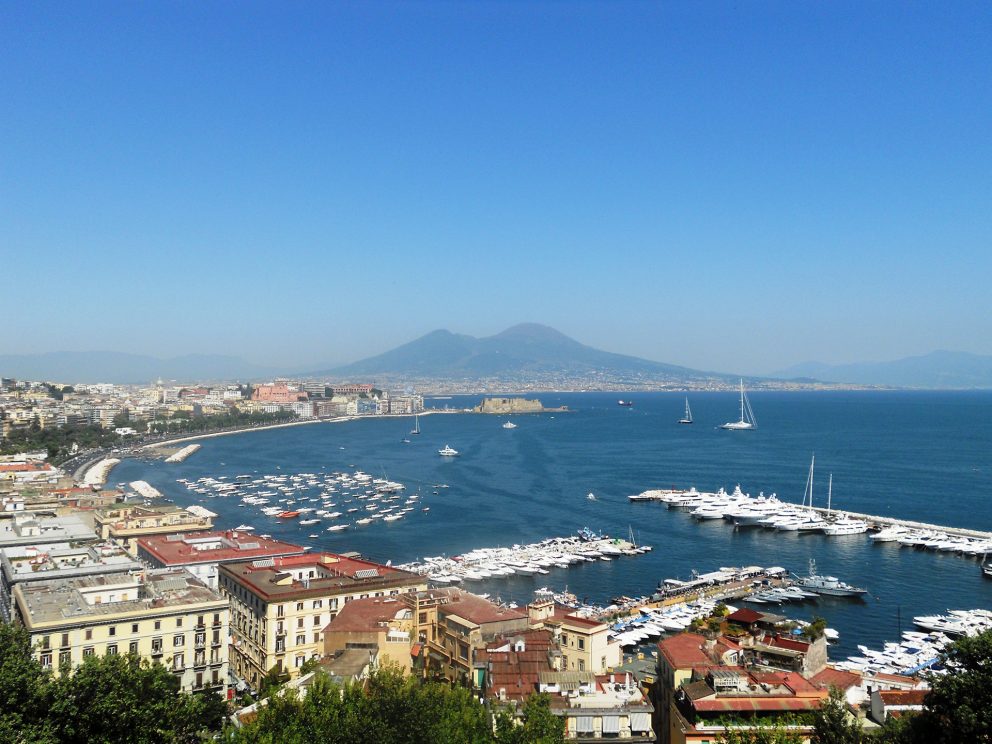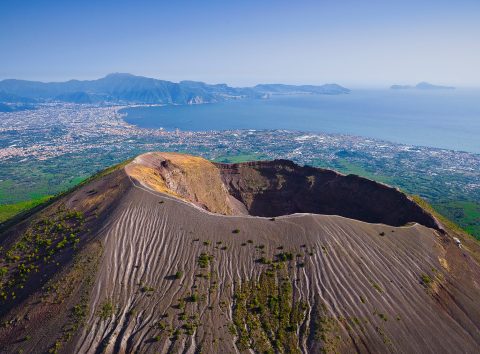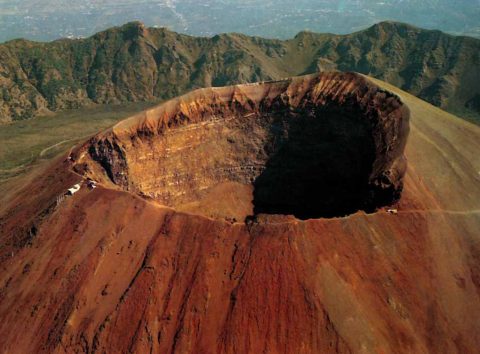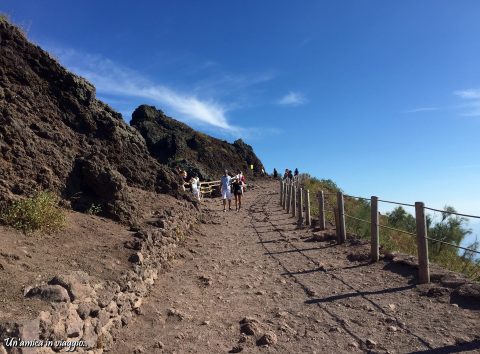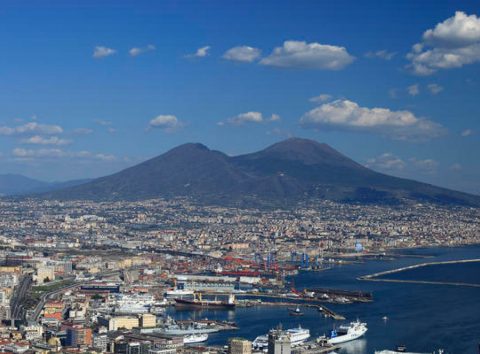Vesuvius
Who doesn't know the Vesuvius? The volcano is the most famous and most studied in the world, due to its particular seismic characteristics and because it is the most cited in literature, the oldest known evidenced of this are narrated by Plinio il Giovane and Tacito, that nearest to us, narrated by the great poet Giacomo Leopardi. Even its geology is fairly rare: a typical example of "volcano a recinto " (fenced volcano), with a trunk,in detail an outer cone Mount Somma (1133 m), within which the smallest cone is represented by Vesuvius (1281 m).
Whilst the height and the profile of Mount Somma remains unaltered, Vesuvius has undergone many changes, with continued rises and drops, because of frequent eruptions.Vesuvius is a distinctive polygenic Volcano, i.e. consisting of lavas of different chemical composition.All areas on the slopes of Vesuvius were formed by land transported by lava, in the rainy seasons, through narrow gorges, riverbeds or more commonly referred to as lakes. The embankments, formed mostly from waste streams, have proved valuable to the vegetation, thanks to their fertile material, rich in potassium and Silicon.
Vesuvius has a particularly rugged and rich history, thanks to its unpredictable movements, and was narrated over the years by the greatest writers and historians. During the Eocene it was an island surrounded by the sea, only in the Pliocene is welded to the Mainland, with a height which reached 2300m. The first historical eruption occurred on 24 August 79 ad, of which there is the account in the letters that Pliny the younger wrote to Tacitus.
Pompeii and Stabia were buried by a blanket of ash and lapilli and Herculaneum was submerged by a blanket of mud. Since then several eruptions have followed, but one of the most violent was in 1139, followed by a long period of stasis, when the volcanos slopes managesd to get covered with vegetation until the top. In 1631 the volcano resumed its activity with a very violent eruption that darkened the sky until the port of Taranto and caused the deaths of 3,000 people. After this date the activity became more intense, with eruptions in 1694, 1767, 1794 (which razed the area of Torre del Greco), 1872 and 1906. The last eruption was in 1944, Vesuvius is currently in a State of stillness. Vesuvius belongs to the category of so-called "grey volcanoes" for the type of material which it emits when it is in activity; gas and ash that forces residents that live up to a hundred kilometres from the crater to flee the area. The Lava is less dangerous, and usually comes out a few weeks after the explosion of gas and lapilli. Its characteristic is the formation of fiery gas clouds formed from materials that fail to rise up in the sky and instead run along the flanks of the volcano, incinerating everything they find. The lighter materials manage to climb, but after fall to Earth in the form of rain.
Vesuvius, although one of the most monitored Volcanoes, with special and modern equipment, still causes fear as an eruption could raze to the ground the thousands of homes built on its slopes which, in certain cases, reach even 700 meters up its sloops. Vesuvius is one of the greatest attractions of Campania's territory, both for its eruptive history, known everywhere, and for its geological and structural conformation that is now as an icon of Naples, appearing in the background of the most beautiful views of the coast. From above the crater, looking towards the Sea you can see the beautiful views of the Sorrento Coast, the Gulf of Naples, Capri to Cape Miseno, Procida and Ischia.
Managing the conservation and protection of Vesuvius since 1995 is the National Park of Vesuvius, it is 8482 hectares and one of the smallest of Italy, but offers visitors stunning itineraries. Many are the places to visit, from volcanic rocks and dense forests to city centres and ancient cities razed to the ground by eruptions. In addition to this Vesuvius, on the South side of the track walked by tourists, can be seen the fumaroles that emit gas at approximately 80 ° C temperature (400 ° C after the eruption of 1944) and another to the East that retains a temperature of 500 ° C. One can visit other places of historical and naturalistic impotìrtance : The Osservatorio Vesuviano, for example, wanted by Ferdinando II di Borbone and opened in 1800, which elegant 19th-century headquarters houses a museum where one can observe lavas, volcanic ' bombs ' and a collection of seismographs of the early twentieth century.
A large natural amphitheatre which is named atrium of the horse, situated between 800 and 850 meters high at the base of the walls of Monte Somma, and which took its name from horses and donkeys left here by tourists headed to the crater. The Valley of the giant, about 5 km long, is a volcanic field that includes the atrium of the horse and the Valley of hell. It has a predominantly sandy bottom and between the vegetation contains Lichen, the Etna broom, robinia and birch. The Valle dell'inferno, which is a very picturesque and secluded Gorge, which starts from the end of the Valley of the giant. Reache via the end of the road that goes from Ottaviano, within walking distance from the Atrium of the horse, from the side of Ottaviano, via the road from Boscotrecase ‘Matrone’ or downhill from the rim of the crater of Vesuvius. And, finally, the natural reserve of Tirone-Vesuvius, established in 1972 on a surface of 1005 HA for 23 years the only form of conservation of the top of the volcano. It includes the atrium of the horse, most lavas of the 1944 eruption and three quarters of the crater of Vesuvius, the pine trees planted for replanting the territory and the spread of Leccio.
Useful information:
How to reach the Vesuvius:
Vesuvio Sorrento-Distance: 45 km
by train: line Circumvesuviana Sorrento-Naples, get off at Torre del Greco or Herculaneum-Excavations.
By car/bike: taking the ss145 in the direction of Naples, then take the motorway A3 in the direction Naples and exit at Torre del Greco or Herculaneum.
Useful numbers:
Ente Parco Nazionale del Vesuvio: tel. Tel. + 39 081/771.09.11/
Command Station Forest of Torre del Greco: tel. + 39/081/881.20.97
Volcanological Observatory Vesuviano, guided visits to the Museum by appointment: tel. 081/583.21.11

